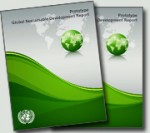
Scientists believe that by following the right policies to promote sustainability— that promote economic growth, social well-being and environmental protection — global society can create a better life for all, by 2050. The findings of this new report, the Prototype Global Sustainable Development Report, show that sustainable development pathways can lead toward a world where by the latter half of the 21st century all regions will be developed, poverty will be eradicated and the demand on natural sources and sinks will not exceed their regeneration capacity.
The report which was released on 1 July, provides governments with an idea of how future Global Sustainable Development Reports can be shaped.
According to the report, historical progress towards sustainable development has been mixed. Some progress has been at the expense of worsening trends in other aspects. Affluence has increased amidst persistent poverty. Improvements have been observed in access to education and gender equality, but intergenerational equity systems, like pensions systems, have come under pressure. The unabated rise in the scale of material consumption has increased global environmental, social and economic pressures. The poor have suffered most the impacts of the rapid increase in materials consumption.
Despite significant improvements in poverty reduction, health, food security and sustainable agriculture, water and sanitation, the world is still faring poorly in a number of areas including reducing deforestation, providing sustainable energy for all, protecting the oceans, providing decent work for all, achieving gender equality and changing unsustainable patterns of consumption.
With right policies, scientists tend to be optimistic on prospects for life in 2050
The report sketches future sustainable development pathways derived from scenarios of leading modelling teams. These scenarios focus on an integrated approach to economic, social and environmental goals aiming at a decent quality of life for all people.
The sustainable development pathways would mark a major departure from the “business as usual” path that the world is presently following.
In the sustainability scenarios, economic growth would no-longer be the primary goal, yet there would be greater global income convergence, particularly as African countries catch-up. Pressures on natural resources could be reduced. Water use would still increase, but less than suggested by historical trends due to accelerated increases in water efficiency and conservation. The use of renewables could triple from 2010 to 2050. And it should be possible by 2050 to reduce air pollution, which would decrease the number of premature deaths globally by 50 per cent by 2030.
Deforestation and land degradation would be slowed and later reversed. The extinction of threatened species would be prevented and the situation of those species in steepest decline could be improved.
Climate change would be addressed by coordinated efforts, through a whole range of possible policies, technologies and regulations, that limit the global average temperature change to 2ºC above pre-industrial levels.
But the world in 2050 would still have its share of problems and challenges. Billions of people would still be living under water stress and flood risks will have worsened in many places. Chemicals would likely continue to pose serious threats to human health. Human interference with the global phosphorus and nitrogen cycles would most likely continue to rise.
The report’s genesis comes from the outcome document for Rio+20, “The Future We Want,” where countries called for strengthening the science-policy in the form of a global sustainable development report, building on existing assessments. As a result, the Secretary-General has asked UN DESA and its Division for Sustainable Development to prepare a prototype for this report, to be discussed at the High-Level Political Forum on Sustainable Development.
For the Prototype Global Sustainable Development Report, 57 international assessments, 69 national sustainable development reports, 125 UN flagships publications, 23 outlook reports prepared by intergovernmental organizations and more than 1,000 academic articles and think pieces have been consulted. In addition, a crowdsourcing platform was created to collect wider views from thousands of scientists across the world, especially the younger generation.
